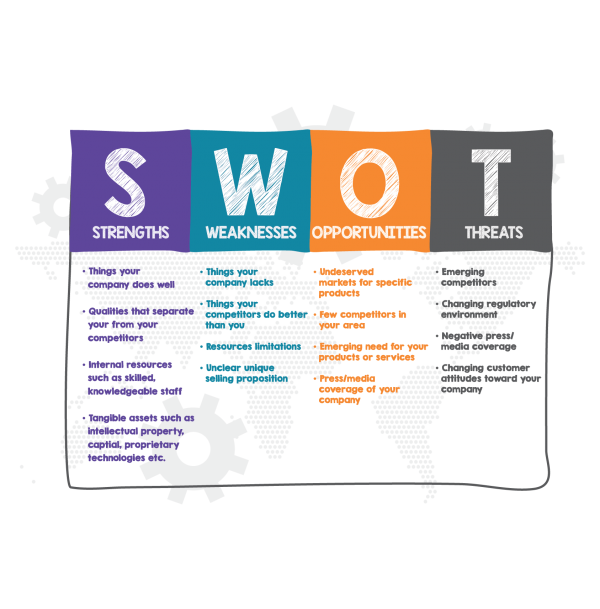Tool’s to make you THINK differently about your business
The SWOT analysis is probably the archetypal marketing or business planning tool, the origins for which have been lost in the mists of time. Some credit an American business thinker, a guy called Albert Humphrey, who worked at the Stanford Research Institute (now SRI International) for its invention. However, whilst he developed other tools, he never laid claim to the SWOT analysis, so the origins actually remain obscure. SWOT like a number of other frameworks for strategic thinking is pretty battle-hardened having been around since the 60’s and 70’s.
When to use it
The identification of SWOTs is critical to the planning processes because the issues identified can often inform the detail of the planning processes and the actions that need to be taken to achieve the company’s objectives.

The identification of SWOTs is critical…
Interestingly (or perhaps otherwise) in the 70’s and 80’s one client of Albert Humphreys was WH Smith and the work he did there, aligning budgeting to long range planning, is reputed to have laid the ground work for the Investors in People scheme.
The model and what it achieves
SWOT then is a strategic / business planning tool used to help an organisation identify its strengths, weaknesses, opportunities and threats related to
1) The organisations current competition
2) The external environment within which it operates
The components of the SWOT analysis break down into two camps. The strengths and weakness are generally internally-related, whilst opportunities and threats commonly arise from the external environment. The name is an acronym of the four parts of the model:
- Strengths: characteristics of the business that give it an advantage over others – strengths might include: Image, reputation, cash in the bank, experience
- Weaknesses: characteristics of the business that place the business at a disadvantage relative to the competition – weaknesses might include: The cost base, old and ageing plant and equipment, poor customer service
- Opportunities: elements in the external business environment that the company could exploit to its advantage – opportunities might include: the opening of a new market, the invention of a new product, a struggling competitor
- Threats: elements in the external environment that could cause trouble for the company – threats might include: Interest rate increases, change of government, changes in technology, a dominant player taking over a competitor to become even more dominant
How to use
As a young engineer many years ago, a short while after starting a new job making diamond tools, my MD introduced me to SWOT analysis and asked me to come up with my version of what I thought the SWOTs were. What I didn’t know was that he’d asked a number of the other engineers and members of the management team to do the same. Once he had all the replies, we had an “away-day” and began to put a 5-year strategic plan together. This was the first SWOT and business plan I was ever involved in (and I’m pretty sure I still have a copy somewhere!).
And whilst the above approach can still be deployed these days, we’d typically start with a PESTEL and Porter analysis and use the results from those to feed into the opportunities and threats aspect of the SWOT.
With the opportunities and threats sorted we’d brainstorm, either individually or collectively, the strengths and weaknesses of the company. It’s more expensive and time consuming but if you have the time and inclination, I’d also involve key customers in establishing their view of the company’s strengths and weaknesses. Their view is often found to be different to the company view and as such often very enlightening.
Related tools
Tools that SWOT can be used in conjunction with, or the results that can feed into it, include:
- PESTEL Analysis
- Porter Analysis
- Critical Success Factors
- Customer surveys
Downloadable resources
Additional references
- Readings in Strategic Management – Ashe & Bowman (great book lots of different case studies)
- Business Guru’s – Ian Wallis – a snapshot of about 30 different business gurus
- Mastering the Rockefeller Habits – Verne Harnish (cheesy title but great easy to read book)



Comments are closed